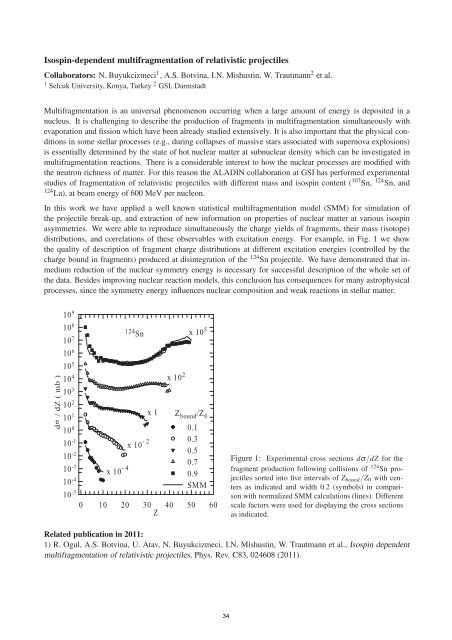FIAS Scientific Report 2011 - Frankfurt Institute for Advanced Studies ...
FIAS Scientific Report 2011 - Frankfurt Institute for Advanced Studies ...
FIAS Scientific Report 2011 - Frankfurt Institute for Advanced Studies ...
You also want an ePaper? Increase the reach of your titles
YUMPU automatically turns print PDFs into web optimized ePapers that Google loves.
Isospin-dependent multifragmentation of relativistic projectiles<br />
Collaborators: N. Buyukcizmeci 1 , A.S. Botvina, I.N. Mishustin, W. Trautmann 2 et al.<br />
1 Selcuk University, Konya, Turkey 2 GSI, Darmstadt<br />
Multifragmentation is an universal phenomenon occurring when a large amount of energy is deposited in a<br />
nucleus. It is challenging to describe the production of fragments in multifragmentation simultaneously with<br />
evaporation and fission which have been already studied extensively. It is also important that the physical conditions<br />
in some stellar processes (e.g., during collapses of massive stars associated with supernova explosions)<br />
is essentially determined by the state of hot nuclear matter at subnuclear density which can be investigated in<br />
multifragmentation reactions. There is a considerable interest to how the nuclear processes are modified with<br />
the neutron richness of matter. For this reason the ALADIN collaboration at GSI has per<strong>for</strong>med experimental<br />
studies of fragmentation of relativistic projectiles with different mass and isospin content ( 107 Sn, 124 Sn, and<br />
124 La), at beam energy of 600 MeV per nucleon.<br />
In this work we have applied a well known statistical multifragmentation model (SMM) <strong>for</strong> simulation of<br />
the projectile break-up, and extraction of new in<strong>for</strong>mation on properties of nuclear matter at various isospin<br />
asymmetries. We were able to reproduce simultaneously the charge yields of fragments, their mass (isotope)<br />
distributions, and correlations of these observables with excitation energy. For example, in Fig. 1 we show<br />
the quality of description of fragment charge distributions at different excitation energies (controlled by the<br />
charge bound in fragments) produced at disintegration of the 124 Sn projectile. We have demonstrated that inmedium<br />
reduction of the nuclear symmetry energy is necessary <strong>for</strong> successful description of the whole set of<br />
the data. Besides improving nuclear reaction models, this conclusion has consequences <strong>for</strong> many astrophysical<br />
processes, since the symmetry energy influences nuclear composition and weak reactions in stellar matter.<br />
Figure 1: Experimental cross sections dσ/dZ <strong>for</strong> the<br />
fragment production following collisions of 124 Sn projectiles<br />
sorted into five intervals of Zbound/Z0 with centers<br />
as indicated and width 0.2 (symbols) in comparison<br />
with normalized SMM calculations (lines). Different<br />
scale factors were used <strong>for</strong> displaying the cross sections<br />
as indicated.<br />
Related publication in <strong>2011</strong>:<br />
1) R. Ogul, A.S. Botvina, U. Atav, N. Buyukcizmeci, I.N. Mishustin, W. Trautmann et al., Isospin dependent<br />
multifragmentation of relativistic projectiles, Phys. Rev. C83, 024608 (<strong>2011</strong>).<br />
34
















